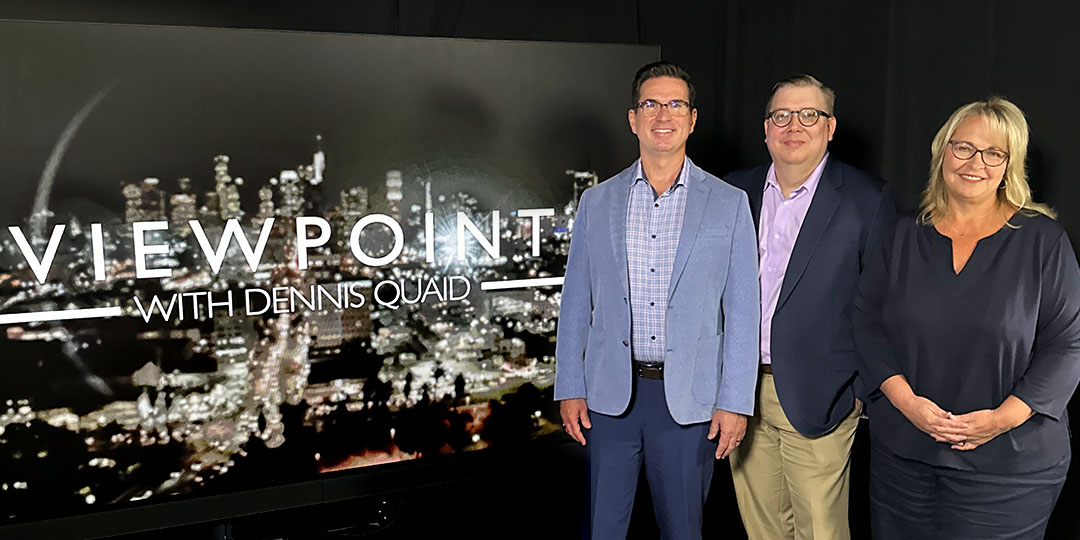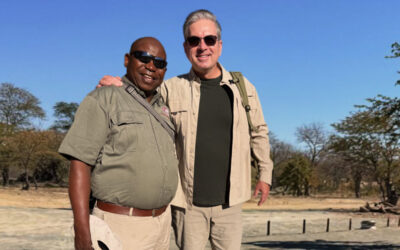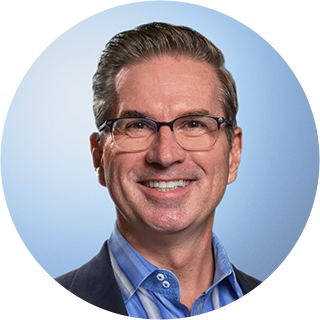Dion Leadership was recently invited to provide content for an episode of Viewpoint with Dennis Quaid, which airs on public television. This invitation arrived shortly after we received Inc. Magazine’s Power Partner Award. Viewpoint’s producer reached out to me and asked if we could bring our best thinking to answer why excellence in leadership development is important for organizations today.
The challenge was to answer that complex, multifaceted question in a seven-minute episode.
What??
I have spent 30 years building points of view on this subject, nuanced with models, content, and customized approaches for bringing coaching, training, management development, team performance, assessment, and organizational development expertise to organizations. The task before me was to distill decades of work into a few minutes of national airtime.
Really??
My first step was to enlist Terri Schell, Dion Leadership’s Practice Leader of Learning and Development. We have collaborated on creating leadership and management development programs for over a decade. I knew she would provide valuable insight to this herculean challenge.
I also realized that it was crucial to include a client’s perspective as we articulated our story. The choice was easy. Chuck Jozwiak, Global Director of Talent at DexKo Global, is a shining example of a talent development executive who gets it! He is strategic and knows how to implement programs at scale. As true partners, we have created multiple Brandon Hall Group HCM Excellence Award-winning leadership development programs.
OK—I felt better!
This mighty trifecta flew to Boca Raton, Florida, to spend a packed day at the Viewpoint studio. Our objective for the project was to motivate business leaders watching the program to truly understand what we so deeply believe—that the most important factors in determining long-term business success are the leaders guiding the organization and the organizational culture that leadership team creates.
We took our mission seriously. Mindful to not come across as preachy or trite, the three of us reflected on our nearly 100 years of combined work experience in the leadership development space. We discussed our individual and collective viewpoints (hmm … I guess that is the reason behind the show’s name!) and distilled them to the most important, relevant, and actionable insights.
Now I was excited—WE GOT THIS!
Recording for nearly a day, we answered about 60 questions and logged hours of footage for the producers’ consideration. It is an odd feeling leaving the studio unsure what the producers will choose to include in the broadcast and what will be left on the cutting-room floor. So, while it is fresh in my mind and in advance of seeing the finished product, I want to pause and share my thoughts on our top five intended messages. We will have to wait and see if they make the Hollywood cut!
Top 5 Viewpoints
1. Too many organizations are sadly still very toxic, and the difference between a toxic and healthy culture is enormous.
Engagement is at an 11-year low. Organizations are suffering from the revolving door of people and employees are reporting record levels of burnout. While it starts at the top of the organizational chart, middle managers shoulder the brunt of this problem. At Dion Leadership, we define a healthy workplace culture as one where all employees are excited to start every day, knowing they will do work that is meaningful with people they respect and trust. And they end every day feeling accomplished, having energy left to give to the rest of their life, like being a parent, spouse, partner, student, or friend.
Healthy cultures have clearly defined and achievable expectations, strong communication systems, and a positive work culture. They provide the tools and resources for each employee to do their best work. They create a sense of belonging, where everyone feels valued. They provide positive recognition and help people grow by giving constructive feedback in a helpful way.
Toxic organizations are driven by fear and self-preservation. They create transactional work relationships where the bare minimum is accomplished; teamwork is poor, decision making is slow, and innovation is stifled. Leaders blame employees, managers are afraid of doing the wrong thing, and employees just do exactly as they are told.
2. To make lasting culture change, organizations should first focus on their leaders and teams.
We have repeatedly proven that one of the best ways to fundamentally improve organizational culture and business performance is through leadership development. At the end of a day, performance is driven through the behaviors and decision-making of the employees. When organizations have a continuous leadership development process that clarifies expectations, teaches best-practice leadership behaviors, and nurtures a culture of learning, great things happen.
Employees today expect to be provided with development opportunities. They want to continuously grow their knowledge and skills. Leadership development is not a one-and-done activity. As the organization changes and people come and go, those same employees need new and different skills. They also need to practice and reinforce what they have learned.
Elite professional athletes still work with coaches every day. Why should it be different for leaders at a manufacturing company, a hospital, a bank, or a retail store?
Imagine that your organization could harness the skills and abilities of all its employees, and that those employees were so committed to your mission that they were passionate about doing everything they could to achieve it. This doesn’t happen from paying employees a lot of money or having rules to keep people in check. Instead, it requires exceptional leadership and management skills to create this environment.
3. There are some key elements that distinguish high-value leadership development programs from others.
Successful leadership and management development programs go beyond the how-to of meeting day-to-day challenges. They emphasize the value of more intangible elements like self-awareness. When leaders better understand themselves, what drives their thoughts and actions, and how others experience them, they can better manage their own behavior and effectiveness.
At the same time, we also know that the best programs are built on a foundation of content that aligns with the organization’s objectives and growth goals. We build our programs to be practical, memorable, and simple to translate into new behaviors back on the job.
This balanced approach gives leaders not only a broader, more refined skillset, but also a mindset to match. The result is increased confidence, the ability to cultivate trusting relationships, and the skills to navigate the adversity and ambiguity inherent in today’s work environment.
4. Organizations should use leadership coaching more often as a key lever to drive change.
We maintain that coaching a single senior vice president with a large span of control creates more organizational value than offering a one-hour skills course to 500 professional staff members. These senior leaders set the tone, and their behavior is modeled by others. I’ve seen firsthand how the change in a single C-suite leader can tip the scales on the culture from toxic to healthy.
We focus on helping leaders cultivate the behaviors they want to constantly see at work. This sustainable behavior change requires a shift in mindset. Consistent coaching assists leaders in building new perspectives as they fully embrace their role in managing others and leading businesses. They become able to lead from a place of authenticity and confidence.
Once a leader selects a leadership coach from a slate of our seasoned, expert leaders-turned-coaches, they begin making profound shifts in the way they see and approach the world. Layering in new and healthy ways of working, interacting, and solving problems creates stronger work relationships that increase accountability and trust, leading to stronger organizational performance.
5. Strategic, trusting partnerships between corporate talent development leaders and external firms bring tremendous value.
Many companies don’t have the resources, time, or skills to build and launch comprehensive leadership development programs. Hiring talent development staff, who in turn need to be oriented and trained, purchase or build content, and get certified or proficient in teaching the programs takes too much time and more money than organizations realize. By leveraging the knowledge and experience of our team of over 60 leadership experts to deploy and develop leadership programs, organizations can bring speed, efficiency, and a competitive advantage to their talent development programs. And as their business challenges change, they can more effectively scale or change their investment.
Many organizations find great value using a delivery model in which senior-level leaders strategically identify their talent management needs and use single-source vendor partners like Dion Leadership to deploy their vision. We are proud to be long-term partners with some very large organizations and help them both design and facilitate leadership programs quickly and effectively. Chuck Jozwiak and our work at DexKo provide a great example of this approach.
Phew! It’s a lot, I know. Probably more than seven minutes’ worth.
When the episode airs, we’ll let you know. Until then, I do hope these five key messages provide you with some insights and inspiration for building a world-class talent management program at your organization.
Read Next
Tomorrow’s Workplace Starts Here
Our 2026 catalog is out and ready for you to download! The theme that our team chose...
8 Leadership Lessons from an African Safari Guide
Earlier this year, I embarked on a life-changing 15-day African safari with my...




